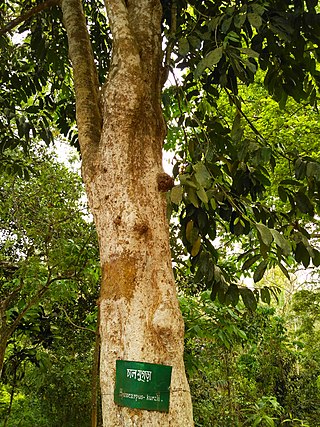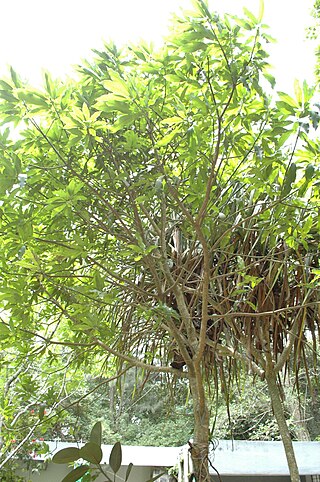
Hydnocarpus is a genus of medium to large trees in the Family Achariaceae; the genus was previously placed in the now defunct family Flacourtiaceae. Species have been recorded from Indochina, Indonesia, Malaysia and the Philippines.

Bactris setulosa is a species of flowering plant in the family Arecaceae. It is a medium-sized spiny palm which is found in Colombia, Venezuela, Ecuador, Peru, Trinidad and Tobago and Suriname. It is one of the largest species of Bactris and is found at the highest elevations.
Napoleonaea lutea is a species of woody plant in the family Lecythidaceae. It is found only in Nigeria. It is threatened by habitat loss.
Elaeocarpus nanus is a species of flowering plant in the Elaeocarpaceae family. It is a tree endemic to Peninsular Malaysia. It is threatened by habitat loss.
Aegiphila cordifolia is a species of flowering plant in the family Lamiaceae. It is endemic to Peru, where it occurs in the Amazon rainforest. It is sometimes found in disturbed habitat.

Gardenia mannii, the nānū, Oahu gardenia or Mann's gardenia, is a species of flowering tree in the family Rubiaceae, that is endemic to the island of Oʻahu in Hawaiʻi. It inhabits coastal mesic, mixed mesic, and wet forests at elevations of 100–730 m (330–2,400 ft) in the Koʻolau and Waiʻanae Ranges. It is threatened by habitat loss.
Hydnocarpus cucurbitinus is a species of plant in the Achariaceae family. It is a tree endemic to Peninsular Malaysia. It is threatened by habitat loss.
Hydnocarpus filipes is a species of plant in the family Achariaceae. It is a tree endemic to Peninsular Malaysia. It is threatened by habitat loss.
Hydnocarpus hainanensis is a species of plant in the Achariaceae family. It is found in China and Vietnam. It is threatened by habitat loss.
Hydnocarpus humei is a species of plant in the family Achariaceae. It is a tree endemic to Peninsular Malaysia. It is threatened by habitat loss.

Hydnocarpus kurzii is a species of flowering plant in the family Achariaceae. It is found in India and Myanmar. It is used as a traditional medicinal plant.
Hydnocarpus octandrus is a species of plant in the Achariaceae family, but originally placed in the Flacourtiaceae family by Arthur Cronquist. It is endemic to Sri Lanka.
Hydnocarpus scortechinii is a species of flowering plant in the family Achariaceae. It is a tree endemic to Peninsular Malaysia. It is threatened by habitat loss.

Kageneckia lanceolata is a species of flowering plant in the family Rosaceae. It is found in Bolivia and Peru. It is threatened by habitat loss.

Mangifera andamanica is a species of flowering plant in the family Anacardiaceae. It is endemic to the Andaman Islands in the Bay of Bengal. The fruits are edible and smaller than the Common Mango. This species is conserved at the Field Gene bank of Jawaharlal Neheru Tropical Botanic Garden and research Institute, Thiruvananthapuram, India.
Pavetta mollissima is a species of plant in the family Rubiaceae. It is found in Ghana and possibly Ivory Coast. It is threatened by habitat loss.
Rhododendron wrayi is a species of flowering plant in the family Ericaceae. It is endemic to Peninsular Malaysia.
Tabernaemontana polyneura is a species of plant in the family Apocynaceae. It is endemic to Peninsular Malaysia. It is threatened by habitat loss.

Hydnocarpus annamensis is a tree in the Achariaceae family. It is found in Thailand, Cambodia, Vietnam, southern Yunnan and southern Guangxi in Zhōngguó/China. It is threatened by habitat loss. The plant produces low-quality wood and its fruits are used in traditional medicine.

Passiflora antioquiensis, the red banana passionfruit, is a species of flowering plant in the family Passifloraceae. It is native to Colombia and is named for the Antioquia Department in Colombia where the type specimen was collected. It was originally described by Gustav Karl Wilhelm Hermann Karsten in 1859. It has gained the Royal Horticultural Society's Award of Garden Merit. With Passiflora tripartita var. mollissima it was hybridised in the Veitch Nurseries in Exeter, England in the 1870s to yield Passiflora × exoniensis, which has also gained the Award of Garden Merit.








